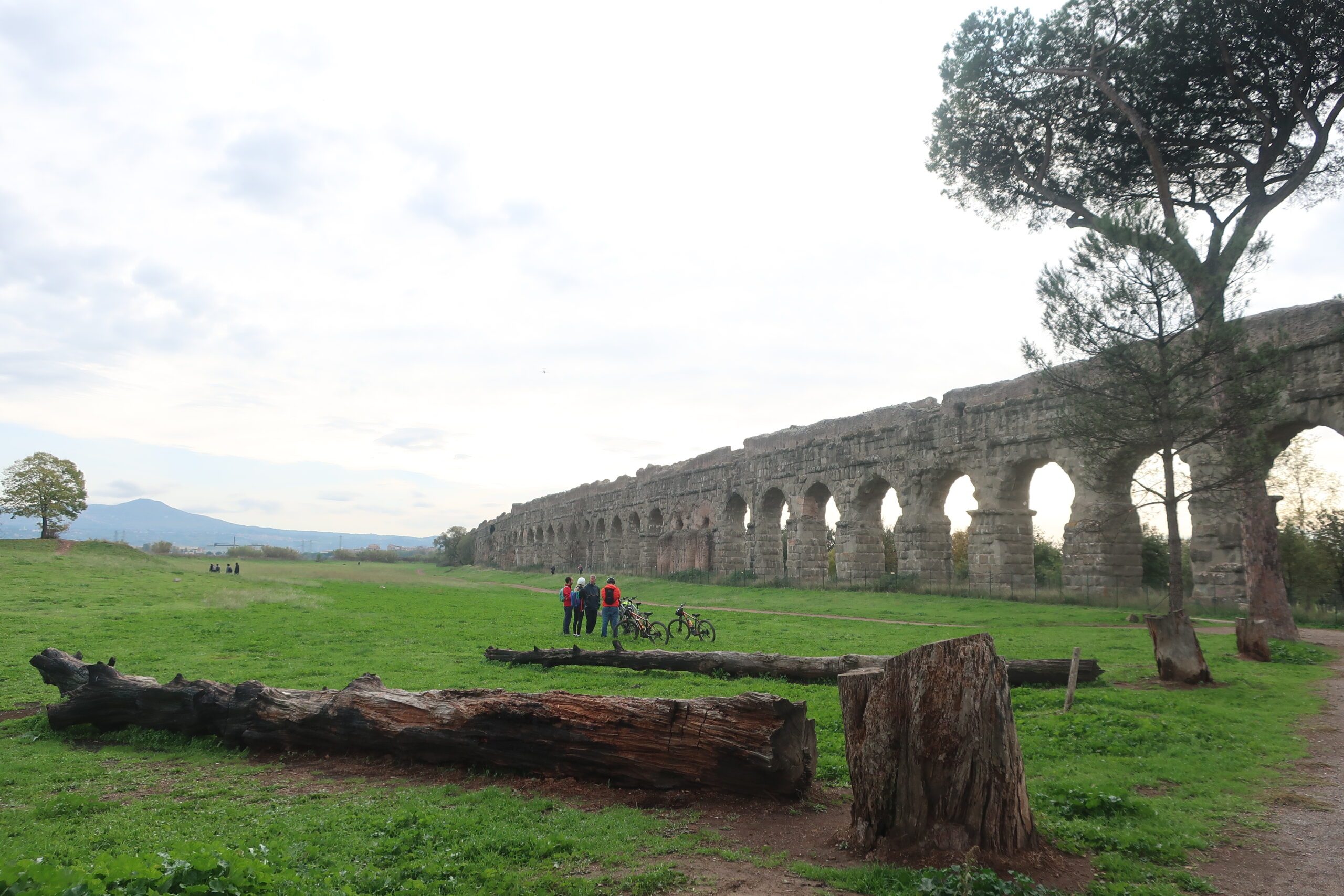Table of Contents
- 1 Travel in Rome] (7) "All Roads Lead to Rome" - Visiting the Baths of Caracalla, the Appian Way and the Aqueduct. Astonished by the amazing technological capabilities of ancient Rome
- 1.1 See the greatness of Rome in the Baths of Caracalla
- 1.2 Now it's time to take the Appian Way - passing the San Sebastiano Gate.
- 1.3 Domine Quo Vadis Church with the footprints of Jesus
- 1.4 The Amazing Civil Engineering Technology of the Roman Empire - Seeing the Technological Capabilities of the Appian Way Road
- 1.5 Impressed by the Claudian aqueduct - a symbol of Roman civilization that has mastered practicality.
Travel in Rome] (7) "All Roads Lead to Rome" - Visiting the Baths of Caracalla, the Appian Way and the Aqueduct. Astonished by the amazing technological capabilities of ancient Rome
Colosseum, ,Foro RomanoI decided to spend another day in the suburbs of Rome to visit the Appian Way and the aqueducts.
As expected, I did not feel comfortable moving around the outskirts of Rome on my own, so I decided to take a tour with a local travel agency. I requestedJimmy Tour."A travel agency called "Tours for the Traveler". They are a travel agency that can provide Japanese-language services, and they are very responsive to details that are difficult to arrange for regular group tours.
I participated in a half-day tour of the Baths of Caracalla and the Appian Way, which included a visit to the catacombs and various other sights within the tour time, which was perfect for me. I am very grateful to Jimmy Tour for the opportunity to meet him during my stay in Rome. I will write more about Jimmy Tours in a later article, but Jimmy Tours also provided me with an amazing experience that I had never imagined. If you are staying in Rome, I highly recommend this travel agency. See the article below for my experience.
So let's get right to the flow of the day.
See the greatness of Rome in the Baths of Caracalla
The first place I visited was the Baths of Caracalla. This large bathhouse, built by the emperor Caracalla between 212 and 216 A.D., could accommodate as many as 1,600 people at one time. It is said that at one time, as many as 1,600 people could bathe in this huge bathhouse.
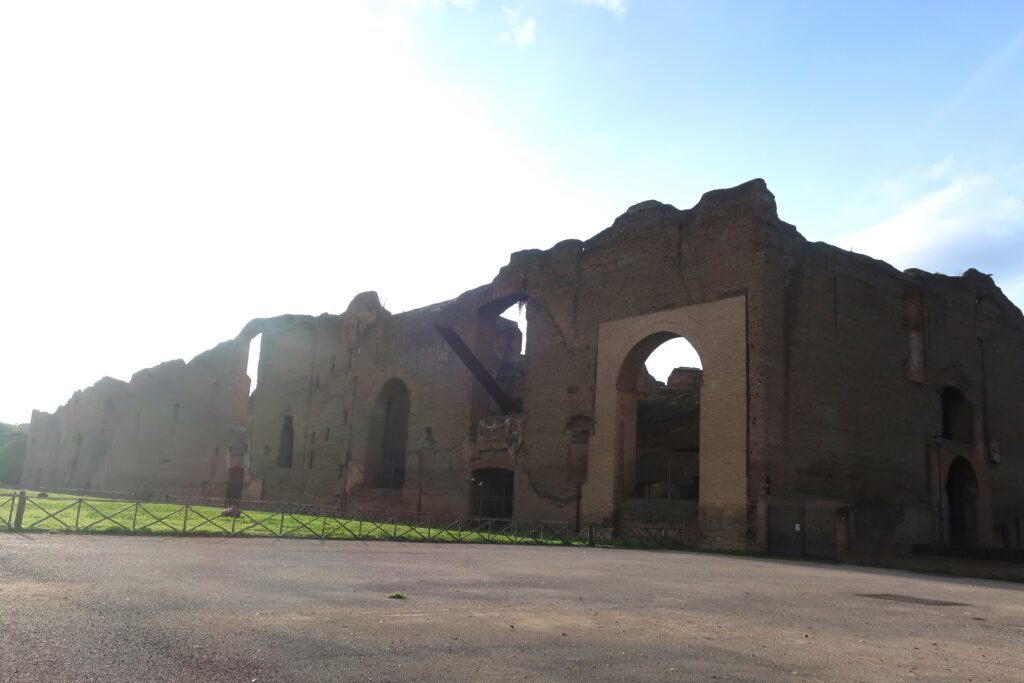
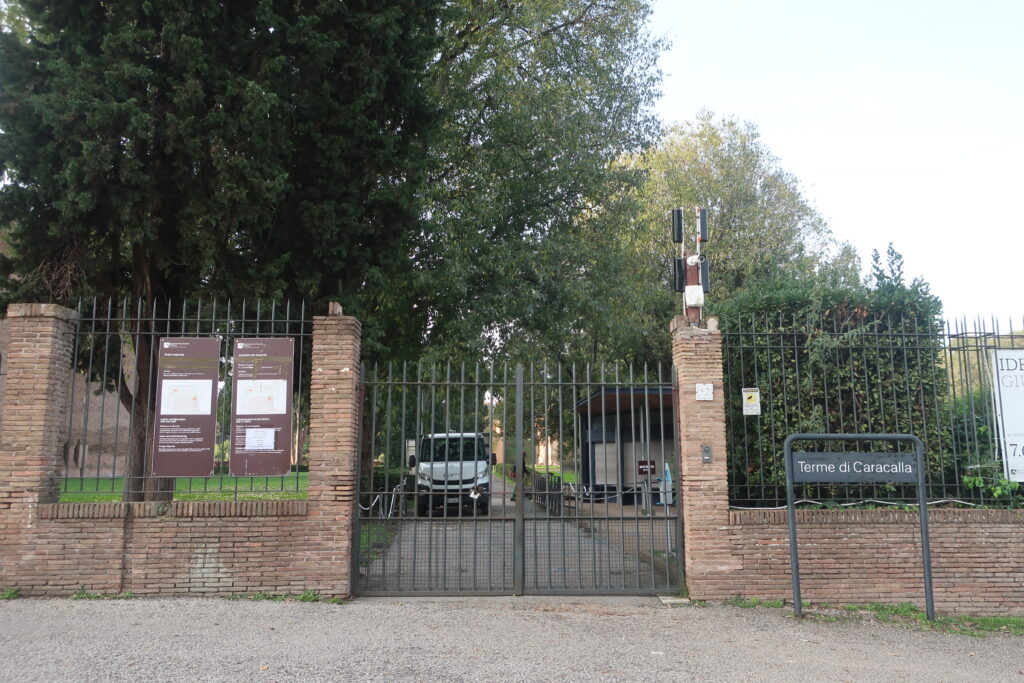
But to my surprise, it was just a regular holiday! Unfortunately, we could not see inside.
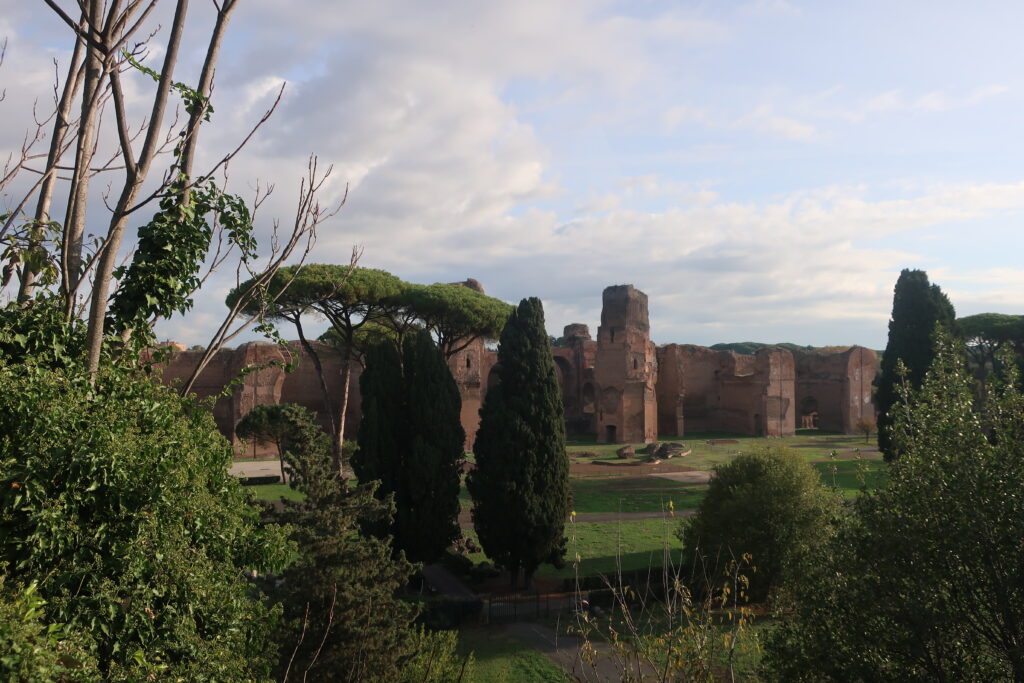
But even from a distance, I could see the enormity of this bathhouse. Even without being able to see it from the inside, I was very satisfied.
Since we are here, let's also look at Masumi Ishinabe's commentary on this Caracalla bathhouse.
As mentioned earlier, the pre-reunification Colosseum was famous for its beauty on nights with a full moon and its lush vegetation. It was not only a magnificent ancient monument, but also an exceptional monument of harmony between ruins and nature. For example, Stendhal, who lavished glowing praise on the Colosseum, praised its majestic beauty as an architectural structure, saying, "The world has never seen anything more beautiful. He also wrote of its unique atmosphere: "How many happy mornings have I spent in the Colosseum, tucked away in a corner of the great ruin? Looking down from the upper floor, I see the papal prisoners in the Arena, singing as they work [on the restoration]. The sound of their chains mingles with the chirping of the birds that are the happy inhabitants of the Colosseum".
What would Stendhal say if he saw the Colosseum today, with its plants pulled out, its arena dug up, and its surroundings asphalted to make it an archaeological specimen?
Like the Colosseum, another site that was famous for its romantic blend of ruins and nature was the Baths of Caracalla. In the preface to "Prometheus Unleashed," the poet Shelley, whose relics are on display with Keats in the Piazza di Spagna memorial, wrote that he wrote most of his poems in the ruins of the Baths of Caracalla, where flowers and fragrant greenery grew thick, and that the blue Italian sky and the breath of spring inspired his drama. The blue sky and the breath of spring in Italy were the inspiration for the drama.
Fortunately, the Baths of Caracalla are far less "environmentally destructive" than the Colosseum. Although it is not the same as in Shelley's time, when one could even climb to the top of the ruins (Stendhal even climbed up to the buttresses to read Gibbon), today the flowers and grasses are left in their natural state, and the tall treetops of umbrella pines and laurel trees make the ruins an ideal place for meditation and strolling. Fortunately, that is not all. Here, one can experience a healthy civic life and the true greatness of ancient Roman civilization, which is a far cry from the frenzy of gladiatorial battles and beast hunting in Rome.
Masumi Ishinabe, Yoshikawa KobunkanAs Long as St. Peter's Stands: My Guide to Rome.p98-100
Some line breaks have been made.
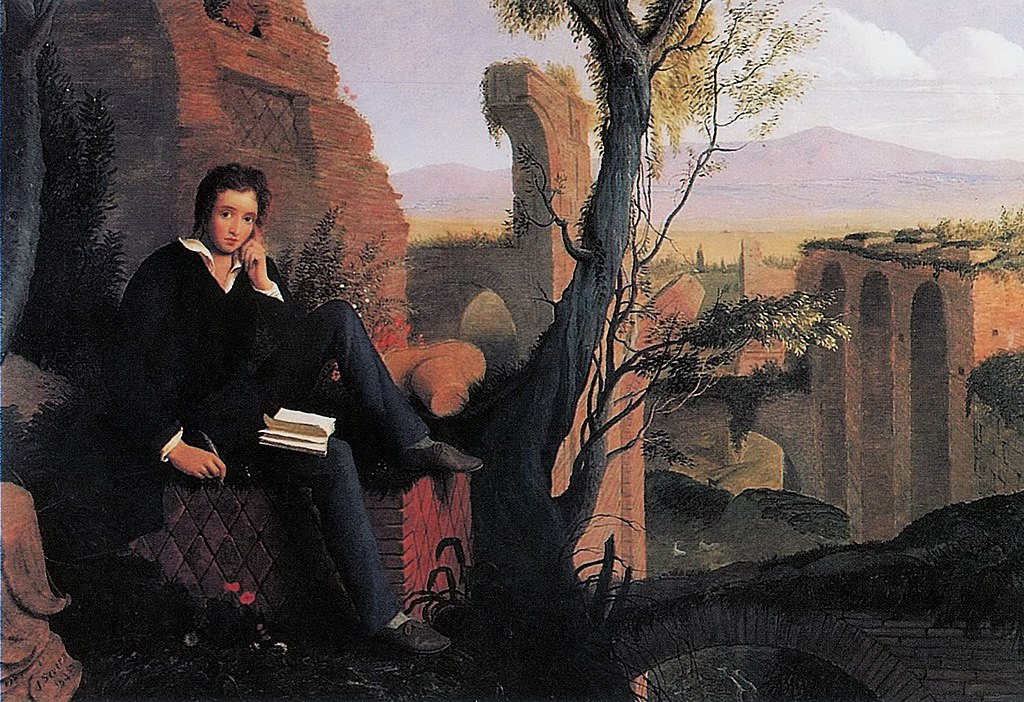
Unlike the Colosseum, which has been dug up and completely turned into a tourist attraction, the Baths of Caracalla still has the atmosphere of good old Rome. Indeed, this is what I also felt from afar.
And at the end of the quote.Today, the flowers and grasses are left in their natural state, and the tall treetops of umbrella pines and laurel trees make the ruins an ideal place to meditate or stroll. Fortunately, that is not all. Here you will find a healthy civic life and the true greatness of ancient Roman civilization, which is a far cry from the frenzy of gladiatorial battles and beast hunting in Rome."It is curious that it was written.
The Caracalla Baths.It is a place where one can come into contact with a healthy civic life and the true greatness of ancient Roman civilization."What does it mean that it is a place? Let's keep looking.
Lanciani, a brilliant nineteenth-century romaesta (Roman scholar), wrote: "Parks, gardens, meadows, and squares have been likened to the lungs of a city. Parks, gardens, meadows, and squares have been likened to the lungs of a city, and if the health and happiness of a city depends on the healthy functioning of its respiratory organs, then in this respect ancient Rome must be considered healthier than any city that ever existed on earth. In fact, according to the literature, at the end of the third century, there were eight campuses, eighteen forums, and about 30 parks and gardens. If we add to these the temple precincts, porticos (colonnades), and thermae (public baths) scattered throughout the city as public places, we can say that the citizens of ancient Rome were indeed blessed. Among them, the Terme, a "huge clubhouse" with all kinds of leisure facilities, supported by a magnificent water supply, is still a glorious legacy of Roman civilization that cannot be seen without marveling.
Yoshikawa Kobunkan, Masumi Ishinabe, "San Pietro ga Tatekiri: My Guide to Rome," P100
The Roman Empire was famous for its welfare policies, but its passion for public baths (terme) was outstanding. 2000 years ago, they drew water from faraway places and continued to supply large quantities of water by boiling it! It is not as if there was a hot spring springing up from underground and they used it as a bathhouse. They drew water from far away and used a large amount of fuel to boil it!
I amThermae RomaeI came to the Baths of Caracalla after seeing the film "The Baths of Caracalla," and this film has helped me to visualize it. The film made it easier for me to visualize how ordinary people of the Roman Empire spent their time in these baths.
Although I could only admire it from afar, I could feel the overwhelming scale and the enormous love the Romans had for their baths.
Now it's time to take the Appian Way - passing the San Sebastiano Gate.
From the Baths of Caracalla, continue south through Rome and you will soon enter the Appian Way.
At its entrance is an ancient Roman gate called the San Sebastiano Gate.
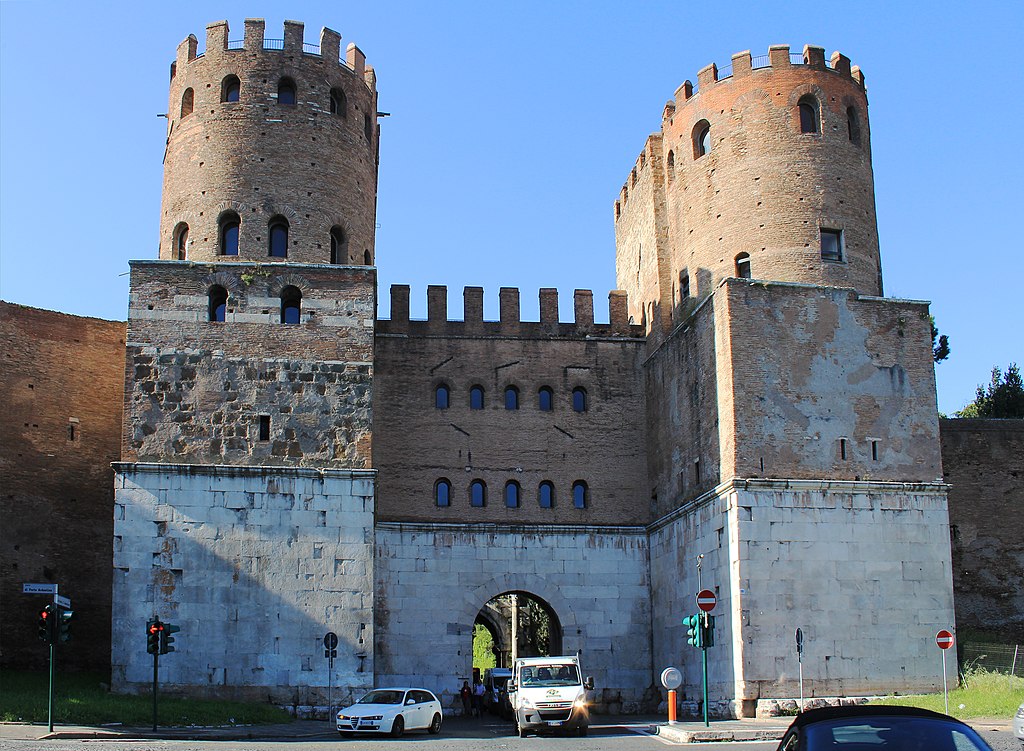
I stopped briefly inside this gate to listen to an interesting story about this gate.
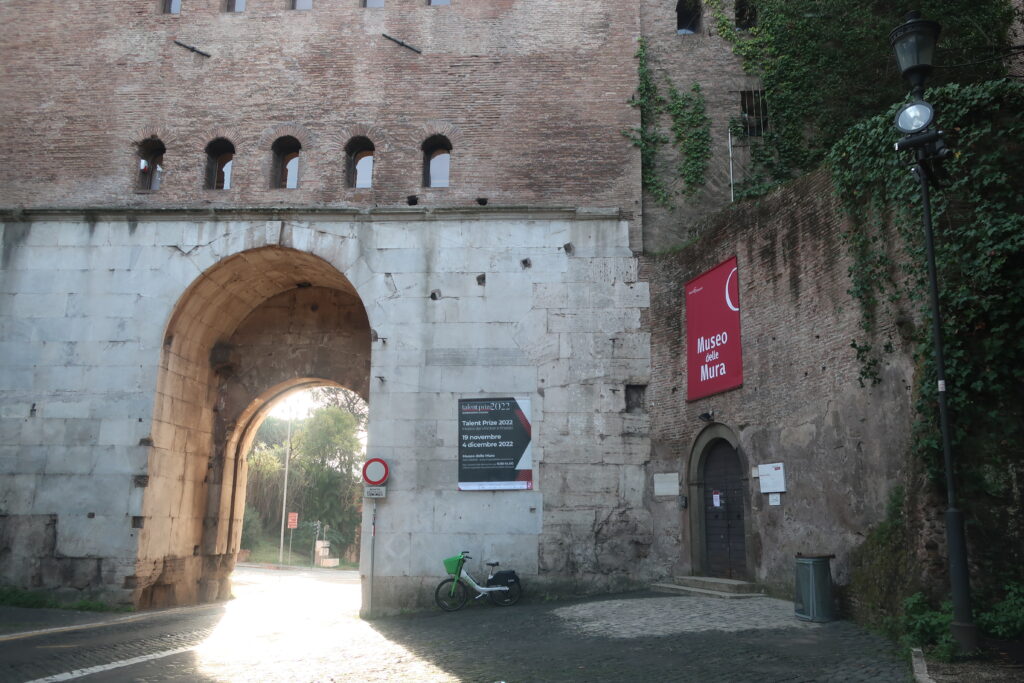
To my surprise, during the era of Mussolini's fascist party, high-ranking government officials used this place as their home. According to our guide, "It's like Nikko Toshogu Shrine being turned into an apartment. It is indeed a terrible thing to think so. It was an episode that gave us an idea of what the Fascist Party period was like.

I was now running on the Appian Way, the same road taken by people 2000 years ago! That alone was enough to get me very excited.
Domine Quo Vadis Church with the footprints of Jesus
And along the Appian Way, there is an interesting spot called Domine Quo Vadis Church.
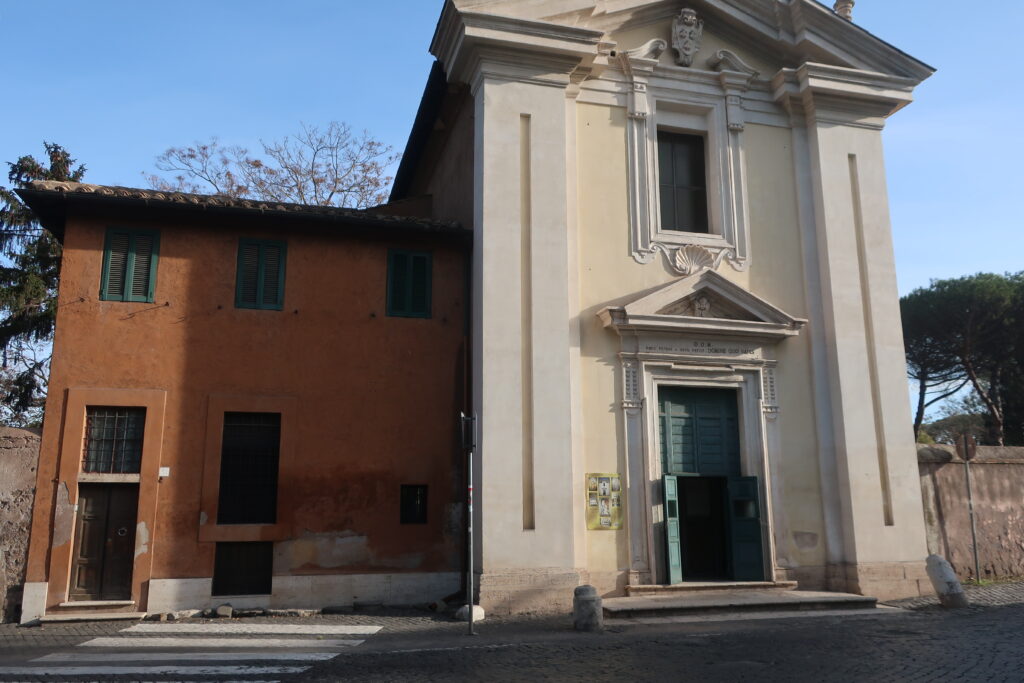
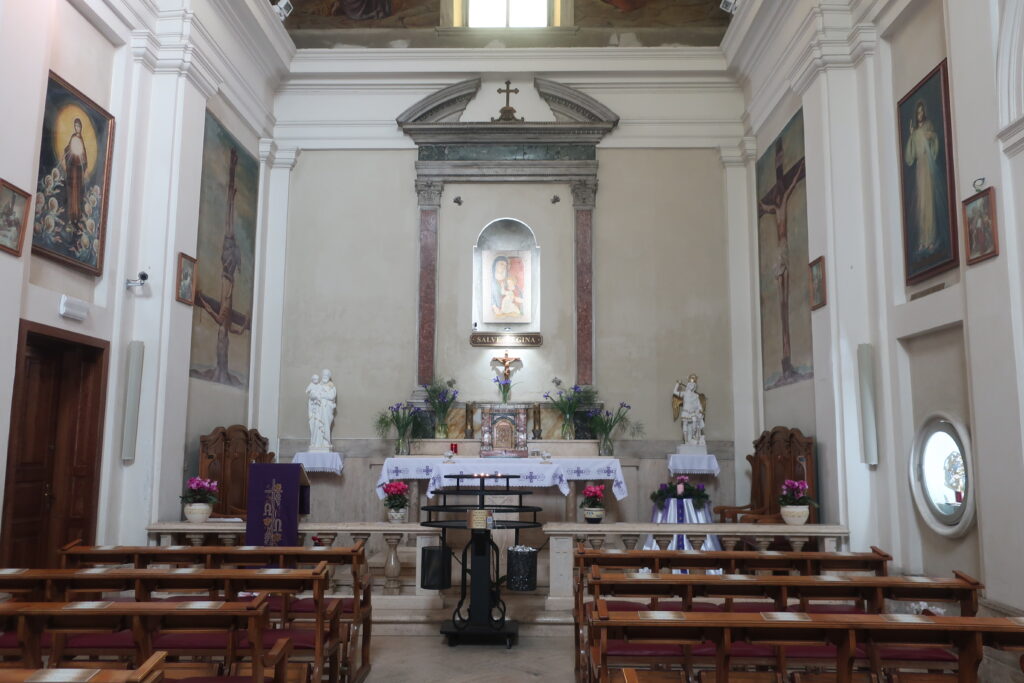
It is known as the church with Jesus' footprints, which can still be seen today.
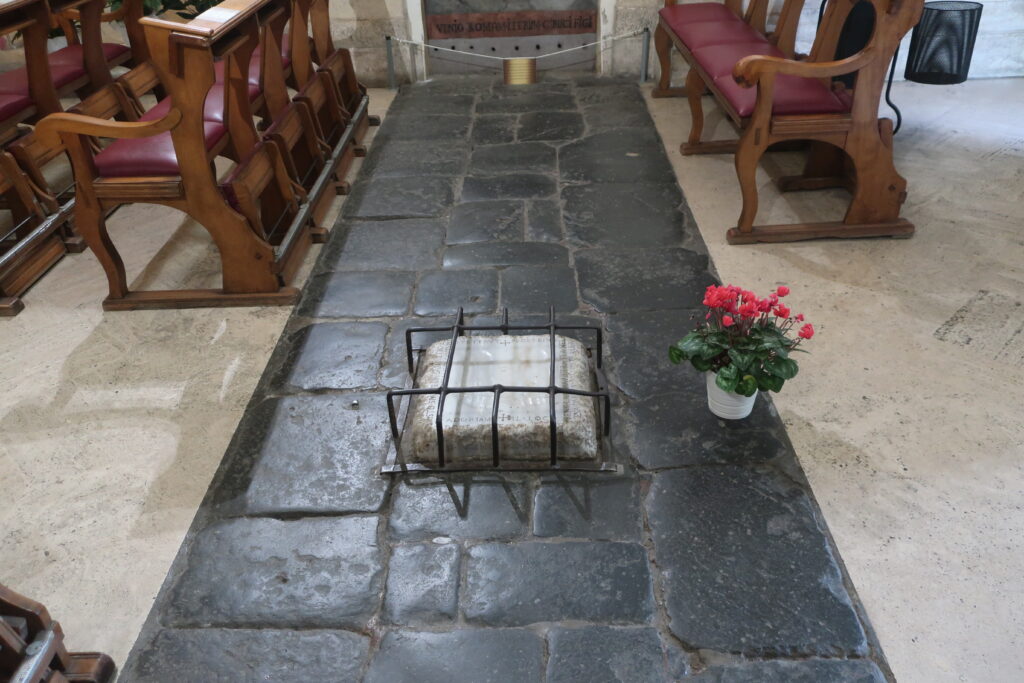
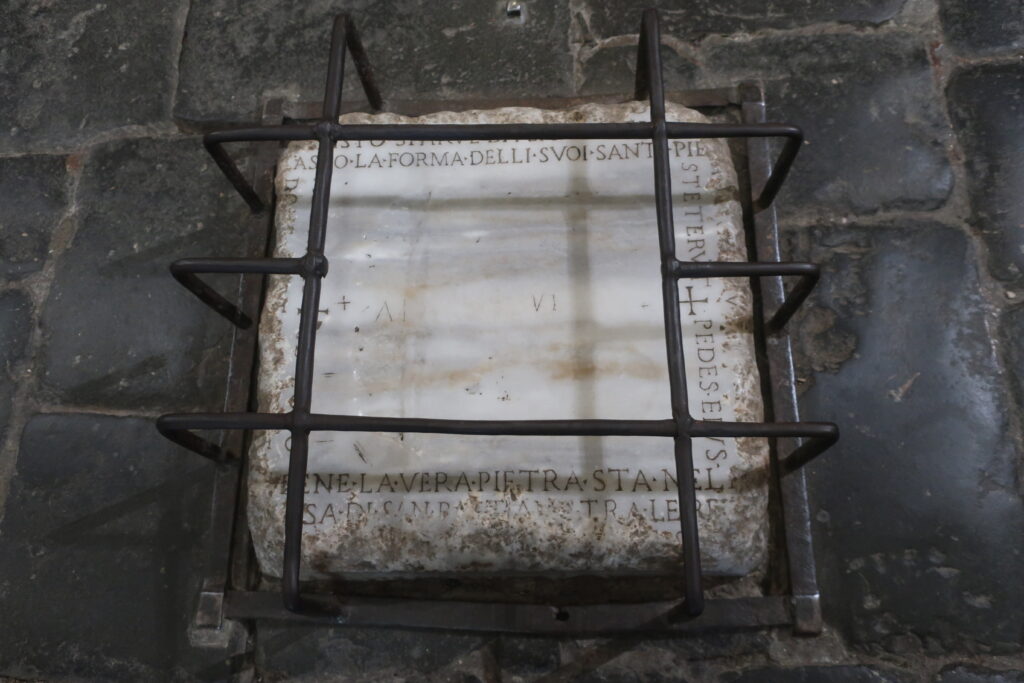
This is the marble where Jesus' footprints are said to have been left.
In Japan, there is a stone called Buddha's Footstone, which is said to contain Buddha's footprints, and it was very interesting to learn that Jesus Christ also has such a tradition.
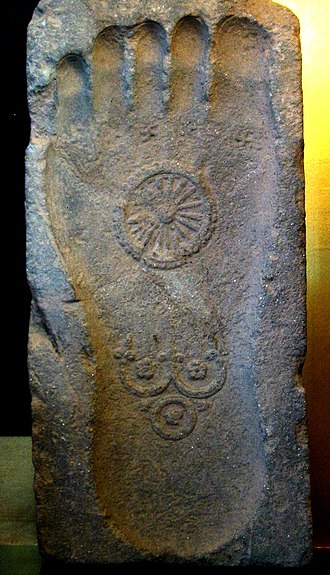
The Amazing Civil Engineering Technology of the Roman Empire - Seeing the Technological Capabilities of the Appian Way Road
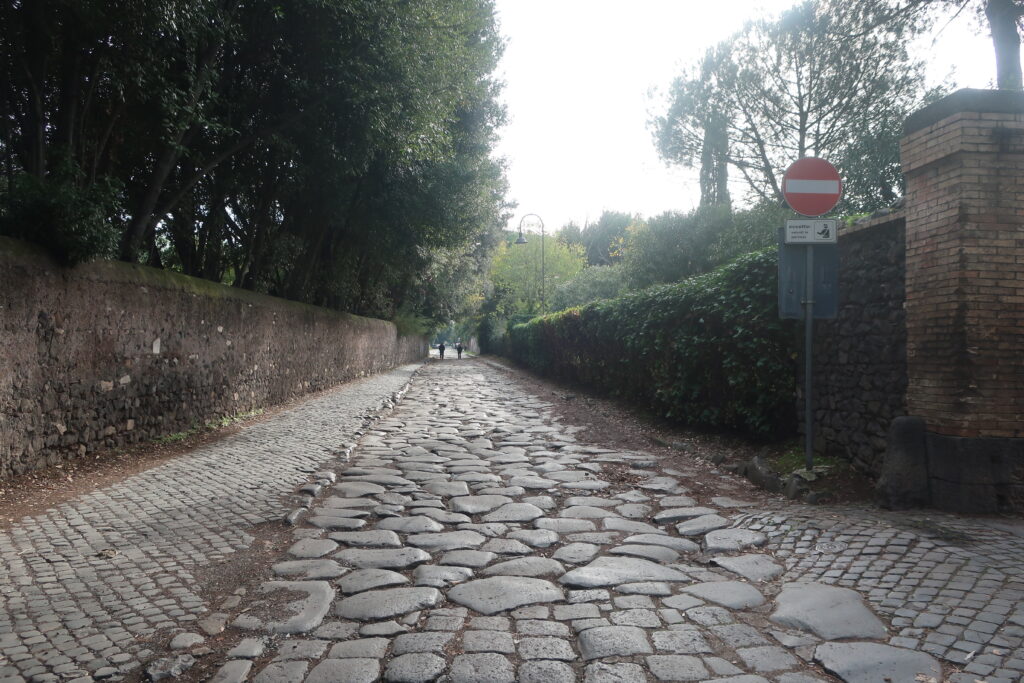
Ancient Roman road on the Appian Way. Nowadays, there are gaps between stones and the road is a little bumpy, but in those days, the road was flat and smooth.
The Roman Empire's civil engineering prowess is well known, most notably in road construction.
By Pierre GrimalRoman Civilization."The translator's commentary in
The adage "all roads lead to Rome" is so well known that the Romans built a network of roads to maintain their empire, connecting their territory from Rome, the capital, to the frontiers along the Rhine, and to the desert fringes of Arabia and the Sahara. Because they were intended to allow armies to rush through in the event of an emergency, they often ran almost straight through the countryside, just like modern motorways. Moreover, for a road to be truly usable as a road, it must not become muddy when it rains or collapse and become impassable. The road surface was firmly paved with stones and ditches were provided. Unlike farm roads, which are merely paved by the footsteps of people and animals, roads are truly structures.
Ronsosha, Pierre Grimal, translated by Yasutsugu Kirimura, Roman Civilization, p. 449-450
WHEREAS.The road surface was paved with stone and ditches were installed. Unlike farm roads, which are merely paved by the footsteps of men and animals, roads are truly structures.As stated above, it is a surprisingly blind spot to realize that roads are also buildings. When we think of buildings, we tend to think of something visible and "standing," such as the imposing Colosseum or houses, but "roads" also contain the technology and spirit of the city.
I am actually witnessing what I learned in this book.
"All roads lead to Rome."
It was an emotional experience for me to witness and touch the path.
Impressed by the Claudian aqueduct - a symbol of Roman civilization that has mastered practicality.
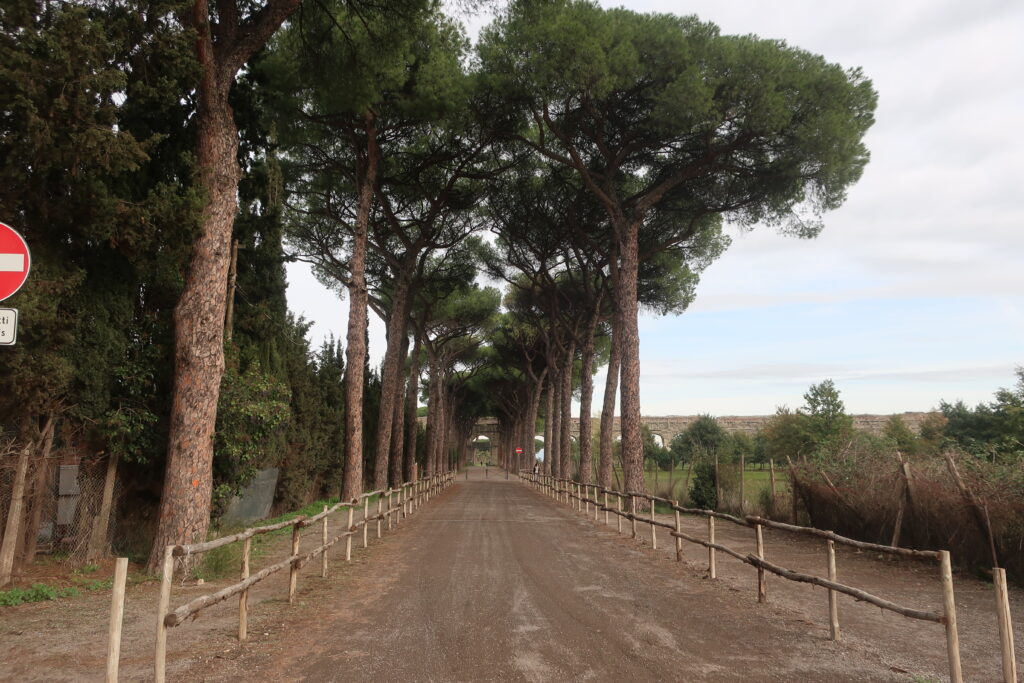
After enjoying the Appian Way, my next stop was the Claudia Aqueduct.
Along with the Colosseum and the Pantheon, the aqueduct is one of the great architectural masterpieces of ancient Rome. I was particularly looking forward to visiting the aqueduct, as I had always wanted to see this masterpiece of engineering.
The aqueduct, already visible in the photo above, is located on the other side of this tree-lined avenue.
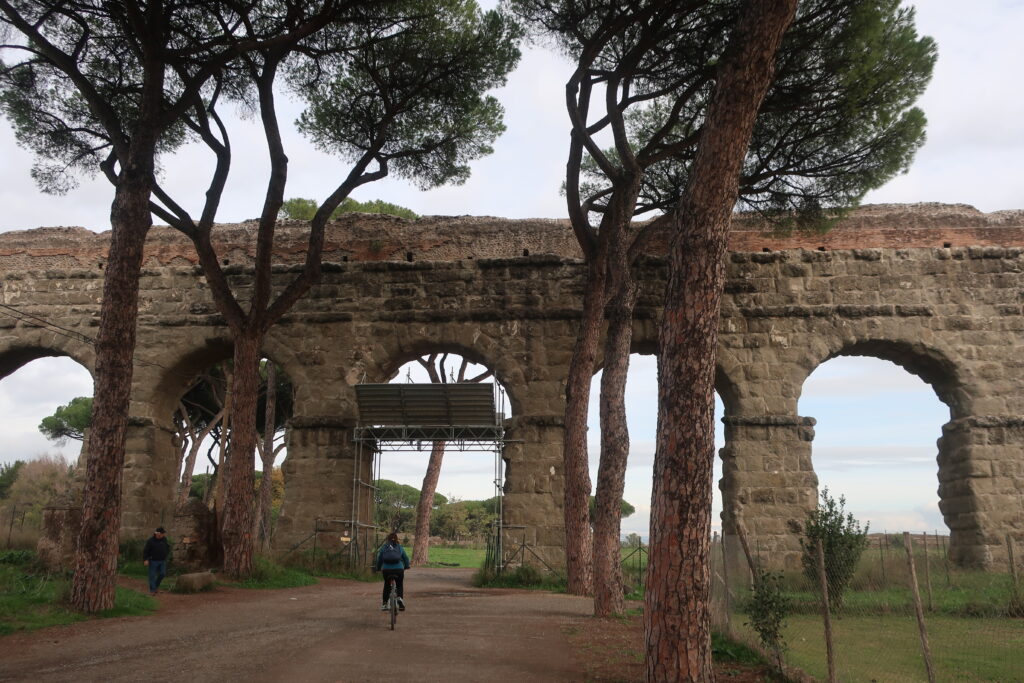
Finally, that aqueduct is in front of us!
It is still big! It is powerful.
It is said that this huge structure was built 2,000 years ago. One can only be exclaimed in awe.
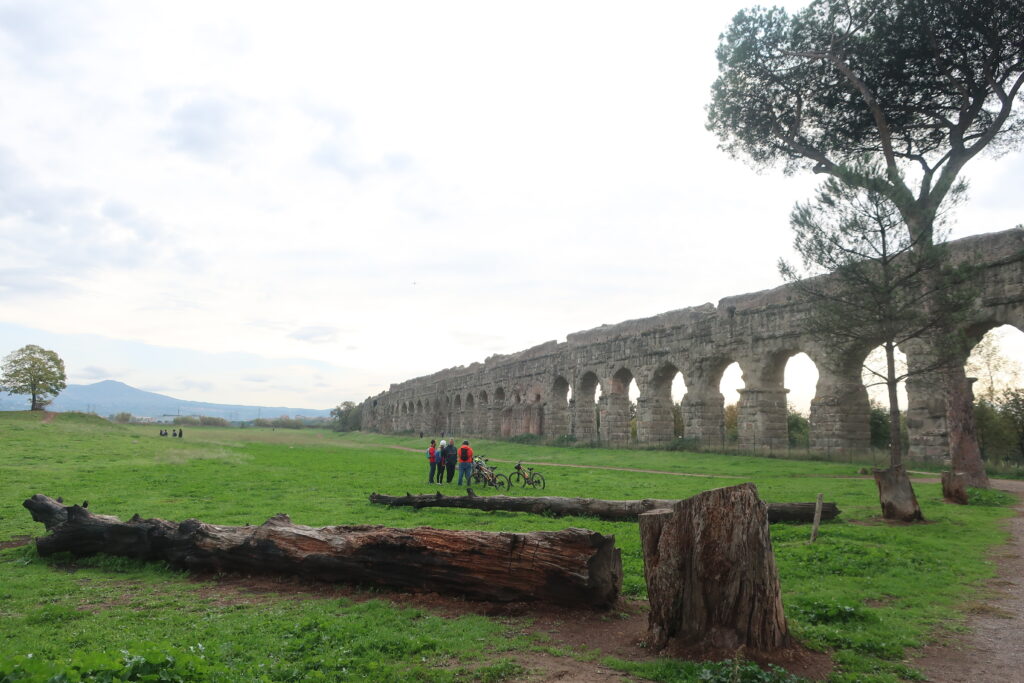
This aqueduct leads from the mountains far beyond to Rome.
The same "Roman Civilization" described these aqueducts as follows.
The aqueduct tends to attract attention solely for its beautiful silhouette and solidity, but its uppermost waterway is also made of stone. There is an expression in Japanese that says "no water leakage," but if the stones are simply combined, water will leak from the joints between the stones and be lost rapidly. Imagining how elaborate the work was to eliminate the gaps between the joints, one can only breathe a sigh of relief. The "Pont du Gard" (*Author's note: Roman aqueduct in France), which still stands firm in the air over the valley after more than 2,000 years, represents not only the superior construction techniques of the Romans, but also their strong imperial will to maintain the city, and the idea of protecting the health of the soldiers and citizens stationed in the city. The aqueduct represents not only the superiority of the Romans' architectural skills, but also their strong imperial will to maintain the city, and the certainty of their approach to protect the health of the soldiers and citizens stationed there. This is the very essence of "civilization.
Ronsosha, Pierre Grimal, translated by Yasutsugu Kirimura, Roman Civilization, p. 449-450
There is an expression in Japanese that says, "Even water does not leak." If you just put stones together in a normal way, water will leak from the joints between stones and be lost rapidly. When I imagine how meticulous the work was done to eliminate the gaps between the joints, it just makes me sigh.
When I first read this commentary, I couldn't help but to be struck in my knees and say, "I see!" I couldn't help but to be struck in the knee.
It is not enough to simply combine stones. Water will seep in and start leaking immediately. To prevent this, there must be precise calculations and perfect construction techniques. The Roman Empire achieved this more than 2,000 years ago.
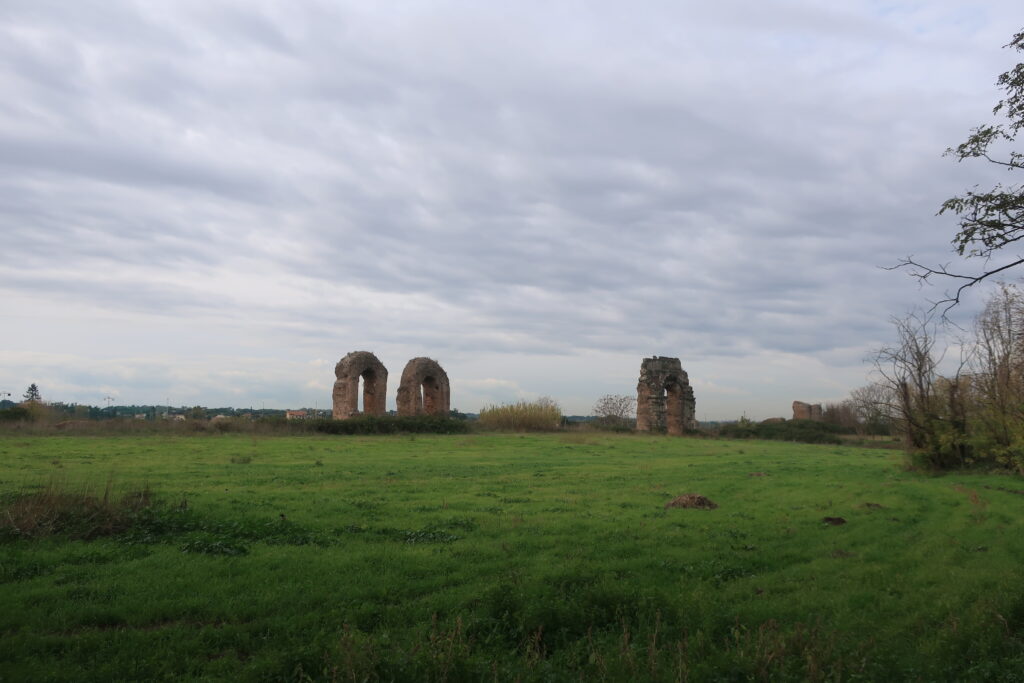
Such a huge structure still remains today...one can only wonder how sturdy it was built.
What our guide told us while looking at these aqueducts still leaves an impression on me.
Both the Greeks and the Egyptians built huge structures. But in the Roman civilization, everything is practical. The Colosseum, roads, aqueducts, all of them are directly related to people's lives. The Greek temples and pyramids are large, but who are they for? But who are they for? What are they good for? Rome is different. The great thing about Rome is that civilization is combined with practicality."
A civilization that has mastered practicality!
I see, this is a very important point to know about the Roman Empire!
It is this practicality that has allowed them to boast so much prosperity.
be unbroken
*The list of articles in the "Rome Travel Journal" can be found atCategory page hereindicates direction or goal (e.g. "to")
*Please visit this category page for recommended books to learn about Rome and Italy.
The Rise and Fall of the Roman Empire, the Vatican, and Roman Catholicism."
The Italian Renaissance and the Revolution in Knowledge."
Next Article.
Click here to read the previous article.
Related Articles











